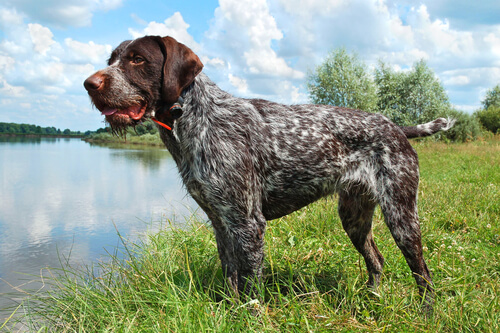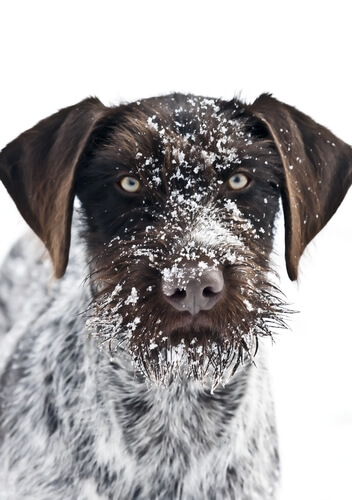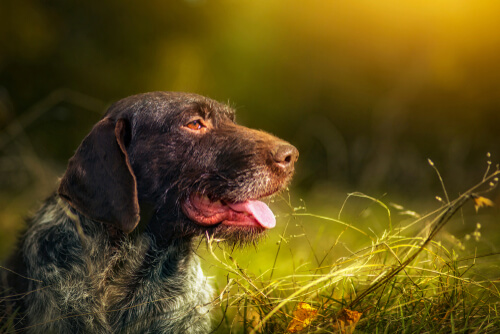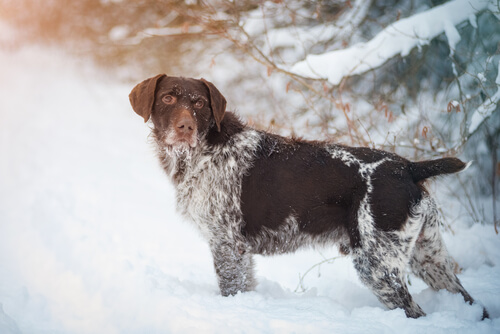
| Kingdom | Animalia |
| Phylum | Chordata |
| Class | Mammalia |
| Order | Carnivora |
| Family | Canidae |
| Genus | Canis |
| Species | Canis lupus |
| Subspecies | Canis lupus familiaris |
| Height | 25 in (64 cm) |
| Weight | 60-70 lbs (27-32 kg) |
| Lifespan | 12-14 |
| Social Structure | Domesticated |
| Natural Habitat | Domesticated |
| Average Litter Size | 8-12 |
| Main Food Item | Dog Food |
| Potential Predators | Few predators |
The Basics
The German Wirehaired Pointer is a large breed of domestic dog. It is a griffon, a type of dog bred for hunting characterized by its coarse, ‘wiry’ hair. The German Wirehaired Pointer was developed in the 1800s and became a common gun dog in Germany in the 1900s. It is a result of the strategic crossing of other species such as the Wirehaired Pointing Griffon, the German Shorthaired Pointer, the German Roughhaired Pointer, and the Pudelpointer.

German Wirehaired Pointers are strong dogs with wire-like fur and a bearded facial fringe. This fur forms a goatee-like feature on the underside and topside of their snouts and is typically lighter than their shorter, darker head fur. In some dogs, this feature is more prominent than others.

Their body is typically white with darker “liver”, brown, or black ticking to varying degrees. Some dogs will even have solid patches of darker coloration depending on the individual. Like other pointers, their tail is typically docked as they were bred for hunting for which this serves a purpose. Otherwise, it is long enough to reach their hocks or about two-thirds of the way down their hind legs. Adults weigh up to 70 lbs (32 kg) and stand 25 inches (64 cm) tall at their shoulders.
Great Hunters and Loyal Pets
Their behavior is typical to Pointers. They are intelligent and enthusiastic hunters, for which they were bred to flush out small game birds such as pheasants, grouse, and quail as well as mammals such as fox and deer. Well-suited for mobility in all sorts of terrain, they have a long history as gun dogs used for tracking larger game as well.

As companions or pets, they are affectionate and determined, if not sometimes stubborn. They are keen to be trained and very people-oriented and loyal. Because of their high energy levels, they are best suited to owners who are consistent in their training approach. They also require a significant amount of exercise in order to prevent some of their potentially less appealing traits from surfacing. The average lifespan of the German Wirehaired Pointer is 12-14 years.
With energy to burn, they may become bored and be prone to escape or roaming if not given the attention and physical activity they desire. Thus, they require a large and securely fenced yard in addition to lots of training and attention. Females typically give birth to large litters of 8-12 puppies. Puppies’ coats may be shorter than adults but are still relatively coarse.
Fun Facts about German Wirehaired Pointer!
Natural Rain Gear
The coat of German Wirehaired Pointers is highly functional and is perhaps their most distinctive feature. There is a dense undercoat that is thick enough to insulate the dogs in the winter but still thin enough to allow them to cool effectively in warm weather. The outer coat, for which they are named, is about two inches long and is wiry and thin, lying almost flat over their undercoat. This outer coat actually repels snow and water, allowing the undercoat to stay dry and retain its insulating properties. As an added bonus for owners of German Wirehaired Pointers, their coats are relatively easy to maintain.

Pointing Dogs
The German Wirehaired Pointer is classified as a pointing dog for its ability to help identify game for hunters. There are generally three types of pointers, including retrievers, flushing dogs, and pointing breed, of which the German Wirehaired Pointer falls into the latter category. They are called “Pointers” due to their tendency to point their muzzle towards the target once they have identified it. Although German Wirehaired Pointers weren’t bred until the 1880s and used for hunting until decades later, Pointing dogs in general date as far back as the 1650s in England and Europe.
A True Generalist
When hunting breeds were being developed in the 1800s through Europe, those outside of the UK took a generalist approach, contrasting the British breeders’ specialist strategy. Their inspiration was to develop good all-around hunters that could work well in most terrains. The German Wirehaired Pointer is an example of the result of this breeding strategy. They are excellent at searching for and pointing to birds and mammals and fearless in their pursuit and retrieval. All the while, the German Wirehaired Pointer is an affectionate companion and an effective watchdog.
